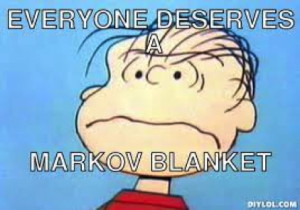I mentioned Markov blankets to Uta and she immediately was intrigued, as was my intention. We talked about it again when we were having lunch on a sunny Saturday in the Angelica Café next to St. Anna church.
Over a nourishing beef broth and a chicken salad, we were sitting under a tree that was just bursting into leaf. We could look across the Danube. Opposite us, in filigree splendour, was the Parliament building. In the distance, to the left, we could see the island in the river that is connected to both sides of the town via Margit bridge. Yellow trams were constantly moving along it in both directions. Toylike.
Uta felt despondent despite the glittering river view, despite the magnificent scenic backdrop, despite the delicious beef broth. She was complaining about people not liking boundaries in diagnostic categories, like autism and dyslexia. They were forever talking about grey areas and one thing shading into another.
“Actually, it’s just the point of Markov blankets that there must be boundaries” – I said to cheer her up.
“Please say more.”
From this point on she couldn’t get a word in edgeways.
How I discovered Markov blankets
I went to a lecture by Pierre Jacob the other day, where I learned that people who believe in embodied and extended cognition hate boundaries. So there is no boundary between the brain and the body – hence embodied cognition – and there is no boundary between the brain and sophisticated tools such as iPhones – hence extended cognition.
Boundaries play such a critical role in biological systems, that it was strange for me to find that some people should hate them. Take for example the cell membrane.
The cell membrane surrounds the cytoplasm of living cells. Very complicated transmembrane proteins span from one side of a membrane the other. These function as gateways to control what enters and exits the cell. Without the membrane, the cell ceases to exist and its components are absorbed back into the environment.
In mammals, the skin acts as a protective barrier. The outermost layer of the skin, the epidermis, forms a protective barrier over the body’s surface, responsible for keeping water in the body and preventing pathogens from entering. Here again complicated mechanical devices are found, such as the ears, mouth and anus, which function as gateways to control what enters and exits the body.
So I started wondering, ‘Is there a cognitive boundary defending and defining that bundle of psychological abilities that we call the mind’?
Fortunately, I had just been reading Karl Friston’s paper on ‘Life as we know it’. This paper introduced me to the concept of the Markov Blanket.
“So, at last – what is a Markov blanket?” Uta asked, looking up from her plate expectantly.
 A Markov blanket separates states in a Bayesian network into internal states and external states that are hidden (insulated) from the internal states. In other words, the external states can only be seen indirectly by the internal states, through the Markov blanket.
A Markov blanket separates states in a Bayesian network into internal states and external states that are hidden (insulated) from the internal states. In other words, the external states can only be seen indirectly by the internal states, through the Markov blanket.
In response to Uta’s frown, I said,
“The blanket is like a cognitive version of a cell membrane, shielding states inside the blanket from states outside.”
I just had an e-mail exchange with Karl Friston to find out more about these cognitive membranes, I told her, opening my laptop.
CDF: Boundaries play such a critical role in biological systems, that it was strange to find that some philosophers hate them.
KJF: This is interesting – I got an e-mail from Jakob Hohwy a few days ago – he just got a paper accepted in “Noûs”. He was also addressing these strange philosophers by talking about “evidential boundaries”. He framed the issue in terms of radical embodiment but clearly wanted to use Markov blankets to bring the boundaries centre stage.
CDF: In cognitive terms, the brain/mind is shielded by a Markov blanket with sensory inputs and motor outputs as the only way of interacting with external states. Does this provide us with a cognitive definition of the mind?
KJF: To my mind (sic) yes. This is because (being completely ignorant of philosophy) I can equate consciousness with inference. Inference is only defined in relation to (sensory) evidence – that necessarily induces a Markov blanket (that separates the stuff that is being inferred from the stuff that is doing the inferencing)
CDF: 3. Are iPhones, laptops, &c. protected by their own Markov blankets? If so, this is an argument against the extended mind.
KJF: Yes it is – this would be Jakob’s position. As I understand it, we still have an internal representation of an iPhone and make active inferences about how we expect ourselves to use it. (But the iPhone itself is outside the blanket and may be making inferences about us.)
CDF: Can Markov blankets form and dissolve over a short time (e.g. during selective attention or joint attention)?
KJF: Yes – I have not thought about this but the Markov blanket is itself an dynamic process and, over time, will visit many different states. I can imagine the sleep-wake cycle being an example of formation and dissolution of a Markov blanket through sensory gating. I will have to think about attention!
Uta has cheered up. “Now we have defined the mind. Next time we can use a Markov blanket to define dyslexia and autism.”
Some more technical stuff
The Markov blanket for a node A in a Bayesian network is the set of nodes composed of A’s parents, its children, and its children’s other parents. The Markov blanket of a node contains all the variables that shield the node from the rest of the network. This means that the Markov blanket of a node is the only knowledge needed to predict the behaviour of that node. The term was coined by Pearl in 1988. (Pearl, J (1988). Probabilistic Reasoning in Intelligent Systems: Networks of Plausible Inference. Representation and Reasoning Series. San Mateo CA: Morgan Kaufmann.
There can be hierarchies of Markov blankets. For example, the Markov blanket of an animal encloses the Markov blankets of its organs, which enclose Markov blankets of cells, which enclose Markov blankets of nuclei and so on.


Delightful, charming, & utterly mystifying. But am left with the feeling that I am transported to the scholastic world of the 12th century. Does such reasoning lead somewhere? Or is only relevant when drinking tea
on the side of the Danube?
Your understanding of extended cognition seems a bit turgid and sloppy. I highly recommend the book “Supersizing the Mind” by Andy Clark.
Hello,
This appears to be, under the surface, a consideration of boundaries within any system, or between two systems. The key here would be to define the system itself, in order to map the boundaries. These would appear – to our chosen method of classifying the system – as soon as we define the system.
This applies not only to physical systems (the respiratory, cardiovascular, or immune systems) but to mental systems, which are very much harder to define. It is here that the problem of testing solutions comes into the foreground, as the basic building block – the system, its boundary – is not agreed as being “this” or “that”, and we revert to evidence based medicine, which is not at all scientific in its replicatory potential, at the causal level, nor is it conclusively falsifiable, from a methodological view.
As a parent of an Asperger´s Syndrome teenager, I suffer long nights thinking about the medication he is given, based on the above problematic. And no certain solutions / alternatives in sight!
Thank you for your hard work. My very best,
Ramon